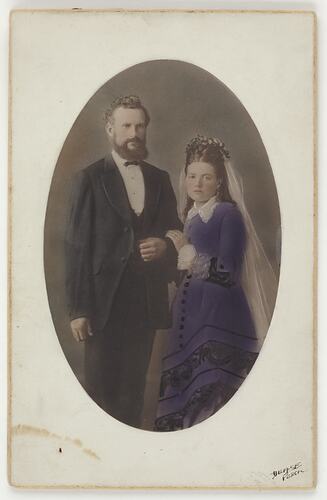Summary
Purple silk wedding dress, worn by Amelia Christina Karolina Simon on her marriage to Charles H. Ferdinand Klopper (Ferdinand Heinrich C. Klopper) on 26 February 1878 at Rosenthal Heights (now Rosedale), Barossa, South Australia. The silk fabric of the dress was probably coloured with one of the methyl violet and aniline blue families of dyes which became fashionable in the decades following the discovery of 'aniline violet', aka 'mauve' or 'mauveine', by William Perkin in London in 1856. Before that, purple was an expensive dye made from murex snail shells, and was a sign of social status.
The dress was donated with a photograph of the bride and groom (SH 892636) that identifies them as Charles and Amelia Klopper. Amelia Simon was born in 1855 in South Australia, daughter of German immigrants Joachim Christopher Ludwig Simon and Anna Haeusler. Charles Klopper was born on 8 December 1851 at Hope Valley, South Australia, also of German immigrant parents - Heinrich Friedrich Klopper and Caroline Wetzel. They were to have 14 children. Their first daughter, Ida, was born in South Perth in 1879. Their next child, a son, Alfred, was born in South Australia, and died at 11 months, in 1881, announced in the South Australian Register: 'KLOPPER.- On the 4th May, at Napperby, of deptethic croup, Alfred Charles, dearly beloved and only son of Charles H. F. and Amelia C. Klopper, aged 11 months. Safe in the arms of Jesus.' Three of their other children also died as young children; another son, Louis Alfred Klopper, served with the 10th Light Horse Regiment during World War I (service no. 150) and was killed at Gallipoli on 7 August 1915. Another son, Henry Ferdinand, served with the 16th Battalion (service no. 332) and became a lieutenant. He served in Gallipoli and France, was shot in the knee, was awarded the Military Cross, and returned to Australia in 1919. Charles Klopper died in 1932, aged about 81, at Bridgetown, Western Australia.
Physical Description
Purple silk long-sleeved dress, likely dyed with methyl violet or similar synthetic dye. Machine-sewn with hand-finished seams. Front opening to below waist from round neck finished with a band with metal hook and eye closure. 16 other metal hooks with 13 eyelets and five worked bars of purple silk thread. Front bodice has two darts either side of opening and small fob pocket on LHS below waist (formerly black silk satin, now clearly worn away). Long straight sleeves ending in three ruffles with black silk satin half cuff with buttoned revere above. Piping at arm hole. Skirt has two asymmetrical bands edged with piping slanting towards LHS. At lower edge of skirt two silk ruffles follow a chevron shape which is emphasised by a black satin ribbon band above. The piped band have black lace attached at lower edge which continue round to back central train panel. Piped bands lace and ruffles then fall symmetrically to train. Cord train carrying loops on lower LHS and RHS. Seam and silk ruffled - piped pocket at right hip. Bands of piping from bodice continue to form panels of train. Shows extensive wear, including at the hem and sweat staining at the back inside collar. Other losses to the fabric are likely to reflect the deterioration of the material over time.
More Information
-
Collecting Areas
Home & Community, Clothing & Textiles, Migration & Cultural Diversity
-
Acquisition Information
Donation from Mrs Reta Peters, 25 Feb 1989
-
User
Miss Amelia C. Simon, Rosenthal Heights (Rosedale), Barossa Valley, South Australia, Australia, 26 Feb 1878
-
Classification
-
Category
-
Discipline
-
Type of item
-
overall dimensions
176 cm (Height)
-
References
People and Places, Short Stories By Ida Amelia McAlinden. Family Notices. (1881, May 18). South Australian Register (Adelaide, SA : 1839 - 1900), p. 4. Retrieved March 28, 2014, from [Link 1] Geneaology from Ancestry.com - Flynn family tree, accessed 28 Mar 2014; McGill family tree, accessed 14 Aug 2015. 'Mauvine', Science Museum, London, [Link 2] accessed 4 March 2021. Day dress T.51&A-1922, 1873. Victoria & Albert Museum, [Link 3] accessed 4 March 2021. 1932 'BIOGRAPHY' [Mr C.H. Klopper], Nelson Advocate (WA : 1926 - 1938), 5 August, p. 6. , viewed 21 Oct 2021, [Link 4]
-
Keywords
Celebrations, Marriage Customs & Rites, Rites of Passage, World War I, 1914-1918, Weddings, Wedding Costumes


